- Table of Content
- 1.Peek a boo
- 2.Review of spac...
- 3.Noticeable Sol...
- 4.International ...
- 5.Geomagnetic Ob...
- 6.PROBA2 Observa...
- 7.The SIDC space...
- 8.Review of Iono...
- 9.STCE Seminars,...
2. Review of space weather
3. Noticeable Solar Events
4. International Sunspot Number by SILSO
5. Geomagnetic Observations in Belgium
6. PROBA2 Observations (1 Apr 2024 - 7 Apr 2024)
7. The SIDC space weather briefing
8. Review of Ionospheric Activity
9. STCE Seminars, Lectures and Courses
Peek a boo
April 8 2024, the Sun and the Moon did their peek a boo trick. People in North America could see the Moon sliding in front of the Sun catching a glimpse of the solar corona with their own eyes.
STCE colleagues travelled to North America to witness this spectacular event but also to discuss and debate with other scientists. The total solar eclipse was a nice opportunity to combine several conferences and meetings.
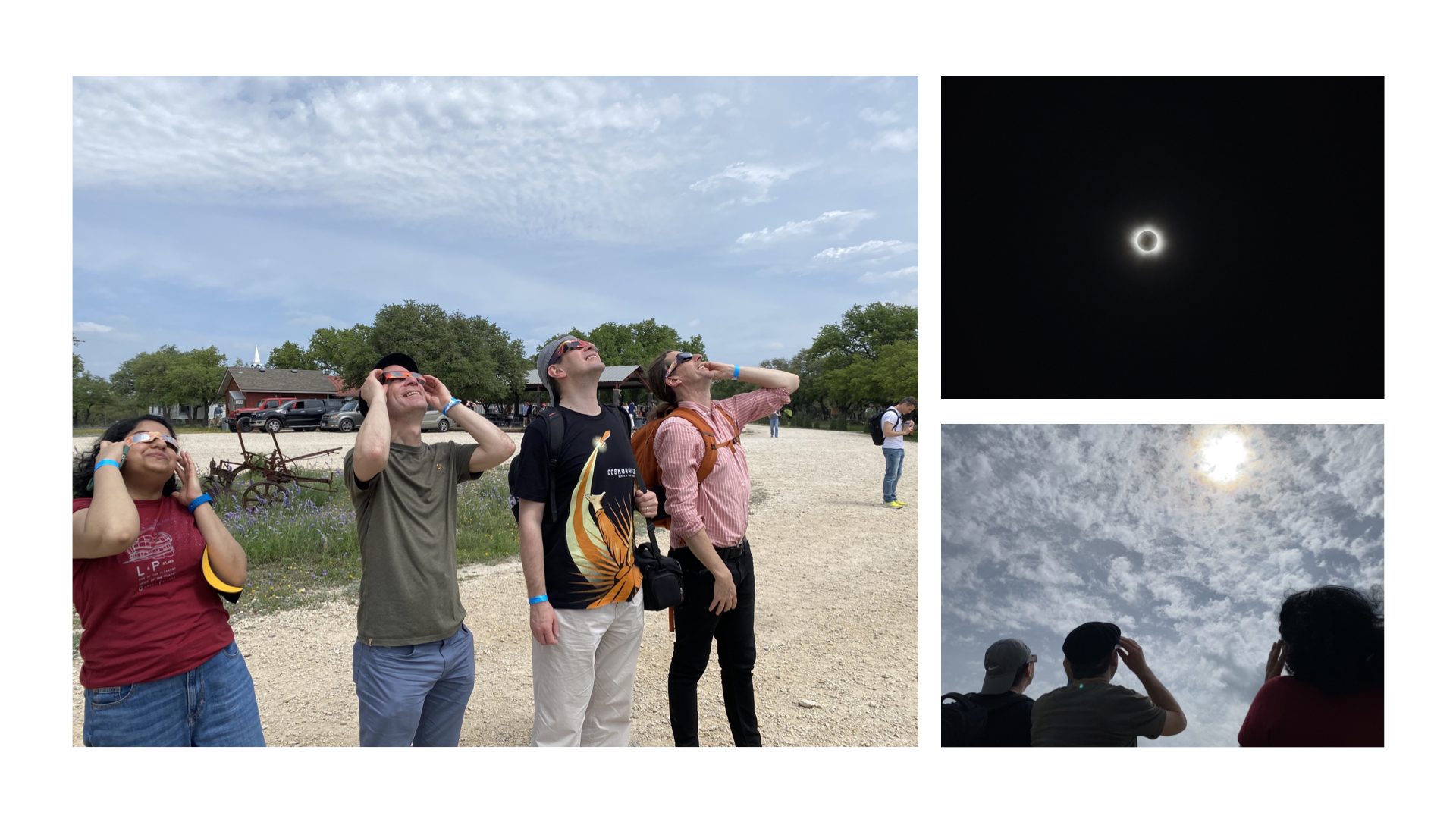
''We saw it! In between the clouds and with some haze but it was quite an experience in any case.''
But scientists want more. They want to go beyond the magical experience and do whatever is possible to investigate the solar wind and the low corona. They go for a profound science investigation from the corona. Like in CSI, but in their case: Coronal Science Investigation
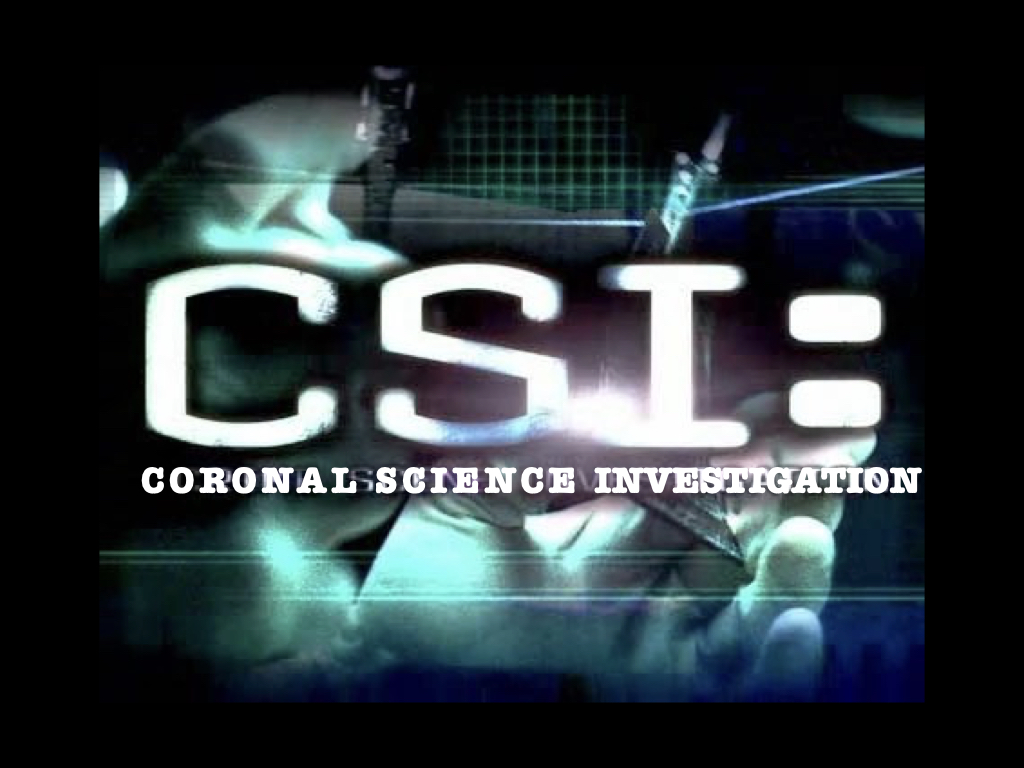
So, an extra-ordinary observation campaign with Parker Solar Probe and Solar Orbiter was deployed. By a lucky coincidence, PSP and SO, both orbiting the Sun, were in the neighborhood at the time of the eclipse because both reached perihelium. 'In the neighborhood' means 7.3 million km for PSP and 45 million km for SO - km from the Sun. People watching the eclipse were at 150 million km.
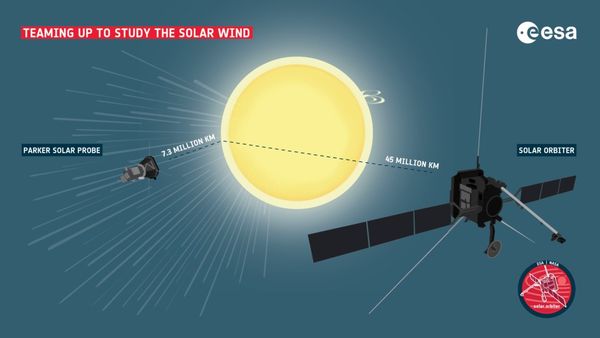
Parker Solar Probe is a spacecraft that can measure the solar wind passing by. It can 'feel' and 'touch'. While Solar Orbiter can see in the EUV what is happening on the Sun and its close environment. From the Earth perspective, we have ground based observations from the corona and EUV pictures from PROBA2.
It is all these measurements and observations from different perspectives that makes this total solar eclipse unique and thrilling.
Review of space weather
Solar Active Regions (ARs) and flares
In the beginning of the week, the solar flaring activity was moderate with an M3.9 flare. This M-class flare was produced by the large Catania region 22 (NOAA AR 3615) on April 1 at 01:32 UTC. The rest of the week, the flaring activity was low with very few C-class flares.
Coronal mass ejections
No Earth directed Coronal Mass Ejections (CMEs) have been detected in the coronagraph imagery.
Coronal Holes
A negative polarity coronal hole crossed the central meridian on April 1. A small positive polarity high-latitude south coronal hole crossed the central meridian on April 07.
Proton flux levels
The greater than 10 MeV GOES proton flux was below the 10 pfu threshold.
Electron fluxes at GEO
Over the past week, the greater than 2 MeV electron flux measured by GOES 16 remained below the 1000 pfu threshold and the 24-hour electron fluence was nominal.
Solar wind
In the beginning of the week, the solar wind conditions were slightly elevated due to the arrival of the high-speed stream from the coronal hole, which began to traverse the central meridian on March 27, previous week. After returning to the solar wind speed regime, the solar wind conditions became weakly influenced by the high-speed stream from the coronal hole that crossed the central meridian on April 1.
Geomagnetism
Geomagnetic conditions reached active levels on April 4 in response to the high-speed stream from the negative polarity equatorial coronal hole that crossed the central meridian on April 1.
Noticeable Solar Events
| DAY | BEGIN | MAX | END | LOC | XRAY | OP | 10CM | TYPE | Cat | NOAA |
| 01 | 0113 | 0132 | 0157 | M3.9 | F | 3625 |
| LOC: approximate heliographic location | TYPE: radio burst type |
| XRAY: X-ray flare class | Cat: Catania sunspot group number |
| OP: optical flare class | NOAA: NOAA active region number |
| 10CM: peak 10 cm radio flux |
International Sunspot Number by SILSO
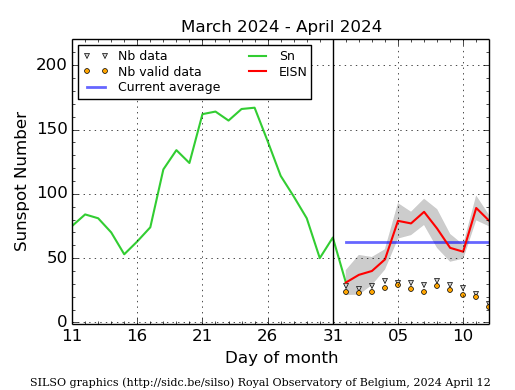
The daily Estimated International Sunspot Number (EISN, red curve with shaded error) derived by a simplified method from real-time data from the worldwide SILSO network. It extends the official Sunspot Number from the full processing of the preceding month (green line), a few days more than one solar rotation. The horizontal blue line shows the current monthly average. The yellow dots give the number of stations that provided valid data. Valid data are used to calculate the EISN. The triangle gives the number of stations providing data. When a triangle and a yellow dot coincide, it means that all the data is used to calculate the EISN of that day.
Geomagnetic Observations in Belgium
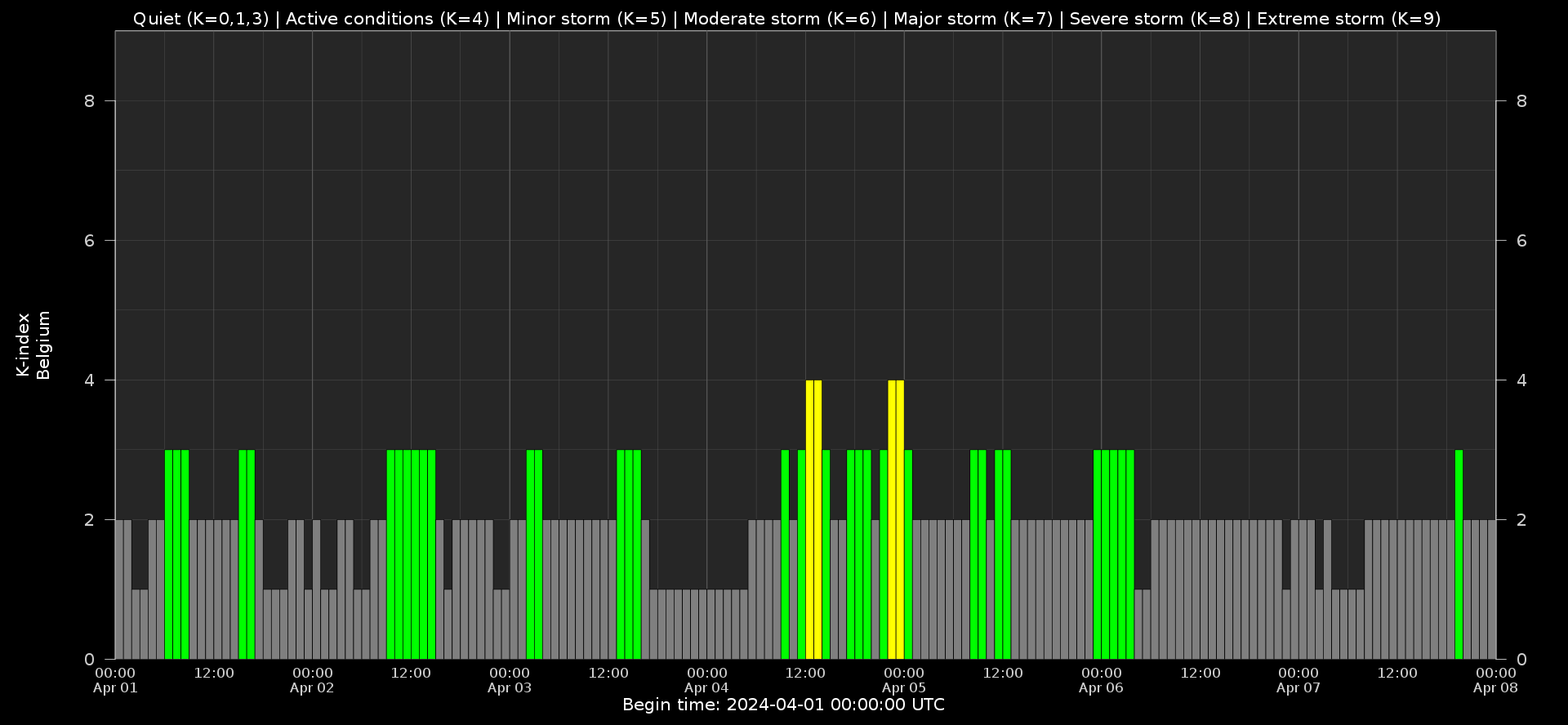
Local K-type magnetic activity index for Belgium based on data from Dourbes (DOU) and Manhay (MAB). Comparing the data from both measurement stations allows to reliably remove outliers from the magnetic data. At the same time the operational service availability is improved: whenever data from one observatory is not available, the single-station index obtained from the other can be used as a fallback system.
Both the two-station index and the single station indices are available here: http://ionosphere.meteo.be/geomagnetism/K_BEL/
PROBA2 Observations (1 Apr 2024 - 7 Apr 2024)
Solar Activity
Solar flare activity fluctuated from very low to moderate during the week.
In order to view the activity of this week in more detail, we suggest to go to the following website from which all the daily (normal and difference) movies can be accessed: https://proba2.oma.be/ssa
This page also lists the recorded flaring events.
A weekly overview movie can be found here (SWAP week 732). https://proba2.sidc.be/swap/data/mpg/movies/weekly_movies/weekly_movie_2024_04_01.mp4
Details about some of this week's events can be found further below.
If any of the linked movies are unavailable they can be found in the P2SC movie repository here https://proba2.oma.be/swap/data/mpg/movies/
Monday Apr 01
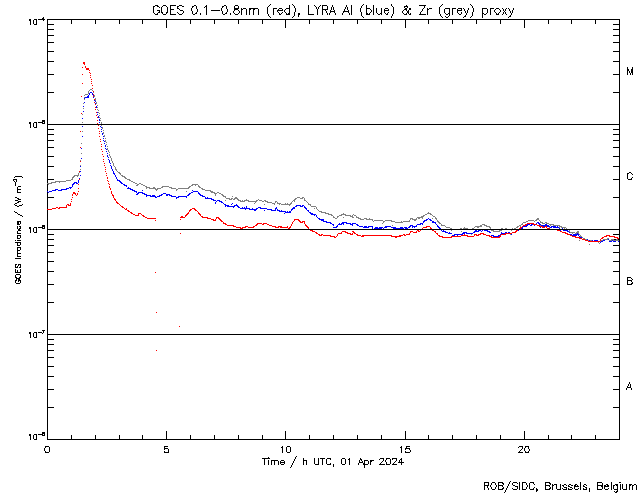
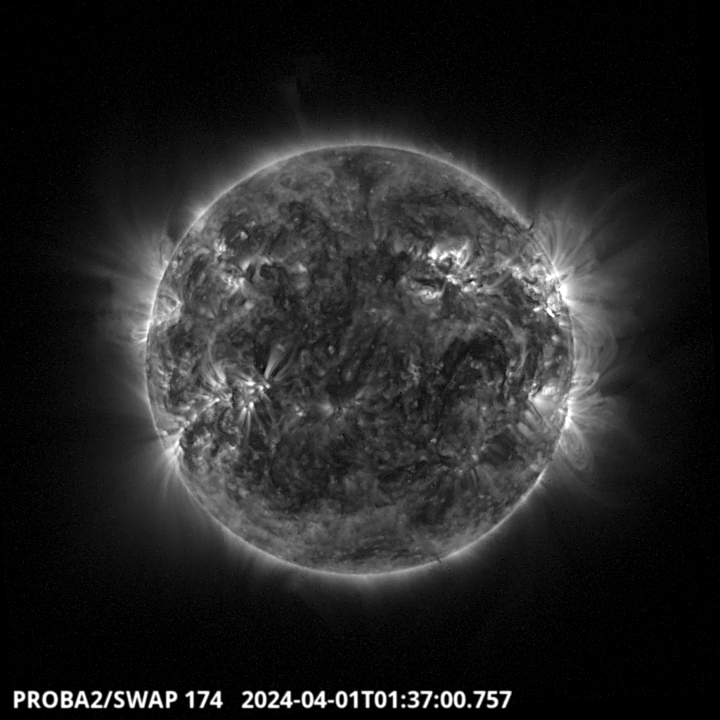
The largest flare of this week was an M3.6. This flare is visible on the SWAP image and LYRA curves around 1:37 UT. It occurred in the western hemisphere close to the limb, it originated from NOAA AR3625. Find a SWAP movie of the event here. https://proba2.sidc.be/swap/movies/20240401_swap_movie.mp4
Friday Apr 07
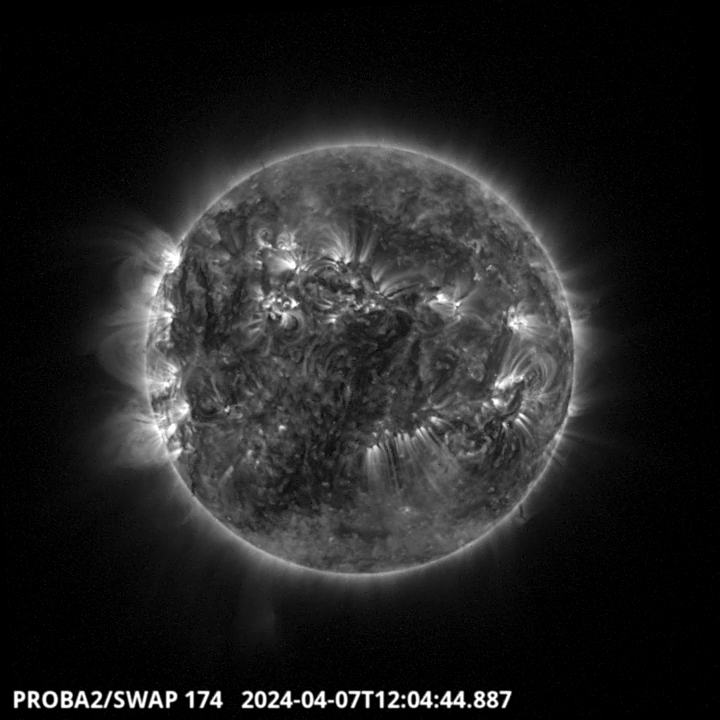
An extended coronal hole is visible in the center of this SWAP image extending toward the South-East part of the Sun. Find a SWAP movie of the event here. https://proba2.sidc.be/swap/movies/20240407_swap_movie.mp4
The SIDC space weather briefing
The forecaster on duty presented the SIDC briefing that gives an overview of space weather from March 31 to April 7.
The pdf of the presentation: https://www.stce.be/briefings/20240408_SWbriefing.pdf
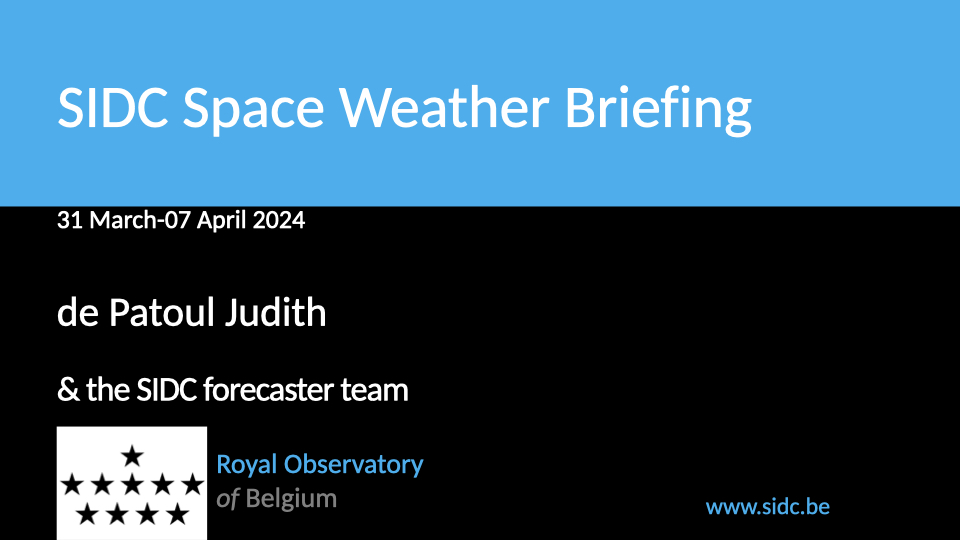
Review of Ionospheric Activity
NEW! The time series below illustrates (in green) the VTEC deviation from normal quiet behaviour.
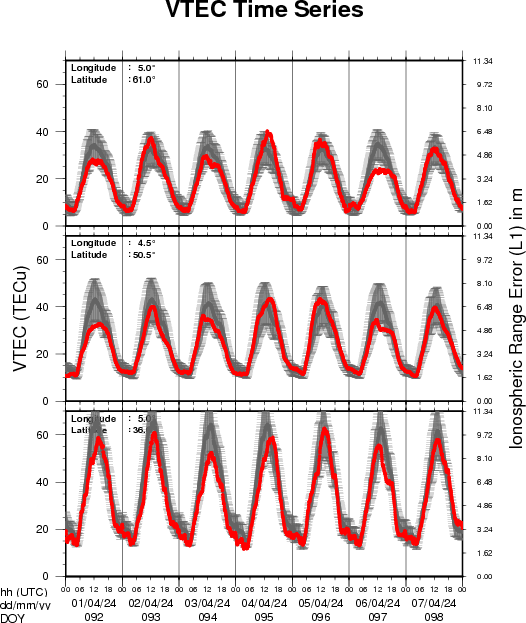
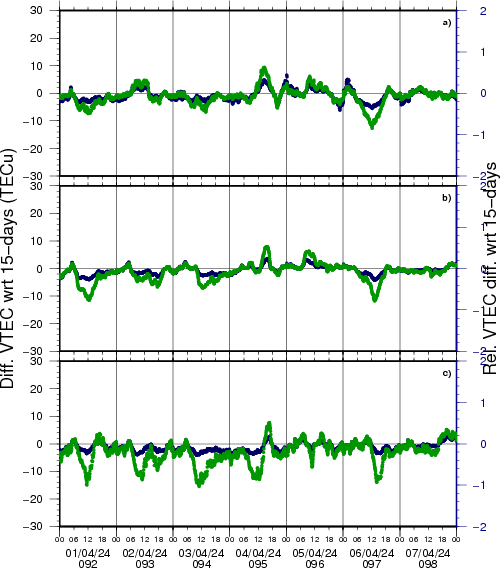
VTEC time series at 3 locations in Europe from 1 Apr 2024 till 7 Apr 2024
The top figure shows the time evolution of the Vertical Total Electron Content (VTEC) (in red) during the last week at three locations:
a) in the northern part of Europe(N 61deg E 5deg)
b) above Brussels(N 50.5deg, E 4.5 deg)
c) in the southern part of Europe(N 36 deg, E 5deg)
This top figure also shows (in grey) the normal ionospheric behaviour expected based on the median VTEC from the 15 previous days.
The time series below shows the VTEC difference (in green) and relative difference (in blue) with respect to the median of the last 15 days in the North, Mid (above Brussels) and South of Europe. It thus illustrates the VTEC deviation from normal quiet behaviour.
The VTEC is expressed in TECu (with TECu=10^16 electrons per square meter) and is directly related to the signal propagation delay due to the ionosphere (in figure: delay on GPS L1 frequency).
The Sun's radiation ionizes the Earth's upper atmosphere, the ionosphere, located from about 60km to 1000km above the Earth's surface.The ionization process in the ionosphere produces ions and free electrons. These electrons perturb the propagation of the GNSS (Global Navigation Satellite System) signals by inducing a so-called ionospheric delay.
See http://stce.be/newsletter/GNSS_final.pdf for some more explanations; for more information, see https://gnss.be/SpaceWeather
STCE Seminars, Lectures and Courses
Courses and presentations with the Sun-Space-Earth system and Space Weather as the main theme. We provide occasions to get submerged in our world through educational, informative and instructive activities.
* April 22-24, STCE Space Weather Introductory Course, Brussels, Belgium - Registrations are open
* April 26, Public presentation Proba-3: a solar eclipse maker, MIRA, Grimbergen, Belgium
* April 30, Solar physics and Space Weather: Proba-2 and Proba-3, online course - Registrations are open
* May 3, STCE seminar, An Echo of the Sun
* May 6, An Echo of the Sun, PhD defense Pepa Ivanova, Brussels, Belgium
* May 13, lecture by the STCE, From physics to forecasting, ESA Space Weather Training Course 2024, Euro Space Center, Redu, Belgium
* May 14, STCE Seminar, Segmentation, grouping and classification of sunspots from ground-based observations using deep learning methods
* May 13 - 17, lectures by the STCE, solar and heliospheric weather; magnetosphere, ionosphere, aviation, and ground based impact, Course Operational Space Weather Fundamentals, L'Aquila, Italy
* May 18, Public presentation, The PROBA-3 Mission: Artificial Total Solar Eclipse in Space, FotonFest, Urania, Hove, Belgium
* May 28, Solar physics and Space Weather: Solar Orbiter Spacecraft, online course - Registrations are open
* June 4, STCE seminar, title TBC
* June 9, Public presentation Total Eclipse of the Sun, Helios, Averbode, Belgium
* June 13, STCE seminar, Solar Prominence Eruptions: Insights from UV Imaging with EUI/FSI
* June 25, Solar physics and Space Weather: predictions and services, online course - Registrations are open
* June 27, STCE annual meeting, Brussels, Belgium
* June 28, public presentation Help! Het stormt in de ruimte!?, Wetenschappelijke middagen, Brussels, Belgium
To register for a course or lecture, check the page of the STCE Space Weather Education Center: https://www.stce.be/SWEC
If you want your event in the STCE newsletter, contact us: stce_coordination at stce.be
